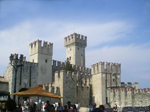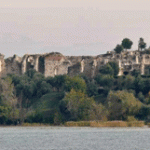Sirmione is perhaps one of the most beautiful places of the Garda lake,
formed a community of German and Austrian nobles and intellectuals – as Gardone thanks to the engineer Luigi Wimmer and in Riva Dr. von Hartungen – proposed the transformation of the town into an elitè tourist center, where the spa treatments, the mild climate, the beauty of the landscape and the rich cultural relics and Roman and medieval remains, contribute to restore a small circle of aristocrats ” (from “Secrets of the Garda” Tullio Ferro). An example of this period is Villa Cortine, built by Baron Kurt von Koseritz to be his private residence by purchasing the whole hill Cortine.Today Sirmione offers tourists the chance to have a special holiday in the comfort of its
many hotels, the kitchen of his numerous quality restaurants, the beauty of its pedestrian zone and shopping in the many shops or strolling through the streets of Sirmione to visit the churches, the Scaligero Castle, the walk under the Grotte di Catullo and the natural beauty of this place . For those who love the outdoors, there are many opportunities for sports, sailing, surfing, water skiing, cycling, horseback riding, hiking and golf, and for those who want to relax and be pampered, there is nothing better than a break at the Terme di Sirmione, with its hot water springs from the depths of the lake and its wellness center.
TERRITORY OF SIRMIONE
Hamlets: Colombare di Sirmione, Lugana, Rovizza
Surrounding municipalities: Desenzano del Garda, Peschiera del Garda (Vr)
Altitude: 66 m s.l.m. – Population: 7.646 – Inhabitants name: sirmionesi
Fractions of Sirmione:
HISTORY OF SIRMIONE
According to some scholars the peninsula takes its name from the ancient greek “Syrma” (tail, bottom) or the Gallic “Sirm” and “ona“, it is certain that the peninsula was inhabited since ancient times. The large Roman buildings, the stones, the trunks of columns, capitals and other relics unearthed in the time testify to the former importance. The history of Sirmione, however, does not stop at ancient Rome, in 568 AD went down the Longobards and without much resistance conquered all of northern Italy, electing as their capital Pavia. As conquered territory, Sirmione had a strategic position as controlled the road from Verona to Brescia and also the one to the South. It seems that on the peninsula there were three churches: St. Martino, St. Vito and St. Pietro in Mavinas, the one dedicated to San Martino coincides with the present church of Santa Maria Maggiore, the church of San Vito and Modesto, which still exists, but that does not coincide with the old building of the eighth century and the church of San Pietro in Mavino, that you do not know the date of construction, which rises on the hill. Entering the park you can see a part of the apse of a fourth Longobard church, the church of San Salvatore in Cortine built between 765 and 774 by Queen Ansa, the wife of the Longobard king Desiderius. In the area between the road of “Caves”, the Lido and the Blondes by Piana were found in the early ‘900, the tombs that testify to the existence of a necropolis. The Longobard Kingdom fell in 774 by Charlemagne, King of the Franks, hence the village and the monastery of San Salvatore were ceded to the monastery of St. Martin of Tours, and lost its administrative importance, disappeared as a district to become a fortified center the territory of Verona. The peninsula of Sirmione in 1197 became subject to the town of Verona and the Verona lordship. The castle, which still can be seen is the work of La Scala, a dynasty that lasted until 1387, then began the long Venetian dynasty which lasted until 1797. Towards the end of the thirteenth century was the scene of Sirmione massacre of Patarines by Alberto della Scala, which narrate various historians and also Tullio Ferro in its “Visti sul Garda” (seen on Garda); in 1276 were captured about two hundred Patarines (Cathar heretics), partly passed to the sword and others brought in Verona and it seems then, in 1278, burned in the arena. During these centuries of Sirmione was a small quiet village inhabited by fishermen-growers within the bridge, while external dedicated themselves to the cultivation of grapes and mulberries. Many were later disputes between residents and those known as “foreigners” on the management of municipal assets.


